The autogiro
evolved from earlier models during this time. While represent a great advance, could neither hover nor descend vertically like the modern
helicopter.
 1930 :
ZAGI 1A also TsAGI , ( USSR )
The Aerodynamic and Hydrodynamic Central Institute 's
vertical flight department was created in 1928 leaded by
G. H. Sabinin .
The ZAGI 1A flown by August 1930, had a fuselage made
of welded tubes, a main rotor with four blades and powered by two
engines of 120 HP installed with a vertical axis.
ZAGI 1A was the first twin-engine helicopter
1930 :
ZAGI 1A also TsAGI , ( USSR )
The Aerodynamic and Hydrodynamic Central Institute 's
vertical flight department was created in 1928 leaded by
G. H. Sabinin .
The ZAGI 1A flown by August 1930, had a fuselage made
of welded tubes, a main rotor with four blades and powered by two
engines of 120 HP installed with a vertical axis.
ZAGI 1A was the first twin-engine helicopter
 1931 : Kuznetzov autogiros ( USSR )
1931 : Kuznetzov autogiros ( USSR )
 1932 : Kay
1932 : Kay
 1932 : Flettner FL 265 ( Germany )
1932 : Flettner FL 265 ( Germany )
 1933, April : Florine ( Belgium )
The first flyable twin tandem rotor helicopter was built by Russian-born engineer Nicolas Florine .
An interesting thing was the rotors did not counter-rotate, they were tilted slightly in opposite directions to counter torque.
1933, April : Florine ( Belgium )
The first flyable twin tandem rotor helicopter was built by Russian-born engineer Nicolas Florine .
An interesting thing was the rotors did not counter-rotate, they were tilted slightly in opposite directions to counter torque.
 1933 : ZAGI 5EA ( USSR )
Their second model had a new rotor with a diameter of 10 m with
three blades rigidly fixed to the hub. Three shorter blades ( 7 m )
were installed between the large ones. They included pitch change
hinges for ensure cyclic control and the auxiliary rotors at the
front and rear of the ZAGI 1A were retained.
1933 : ZAGI 5EA ( USSR )
Their second model had a new rotor with a diameter of 10 m with
three blades rigidly fixed to the hub. Three shorter blades ( 7 m )
were installed between the large ones. They included pitch change
hinges for ensure cyclic control and the auxiliary rotors at the
front and rear of the ZAGI 1A were retained.
Flights results were disappointing and the aircraft was abandoned
 1933 : Breguet - Dorand ( France )
Louis Breguet continues with his efforts and he built a new
coaxial gyroplane with a 420hp Wright engine.
On September 11, 1936 Breguet reaches 108 km/h
1933 : Breguet - Dorand ( France )
Louis Breguet continues with his efforts and he built a new
coaxial gyroplane with a 420hp Wright engine.
On September 11, 1936 Breguet reaches 108 km/h
 1934 : Nikolai Kamov's A-7 gyroplane ( USSR )
1934 : Nikolai Kamov's A-7 gyroplane ( USSR )
 1935 : Elton Whitney ( USA )
Elton Whitney made patterns for the aluminum castings, he had a family friend, who was an expert, make the castings. In the meantime he obtained some spruce to make the fuselage and rotor blades. He was confident that it would work because he had made models, which had flown successfully.
1935 : Elton Whitney ( USA )
Elton Whitney made patterns for the aluminum castings, he had a family friend, who was an expert, make the castings. In the meantime he obtained some spruce to make the fuselage and rotor blades. He was confident that it would work because he had made models, which had flown successfully.
When he received the castings, he discovered that the patterns he had made had not been correct and the castings would not fit together, so he abandoned the idea of building a full size machine, and simply made drawings of his idea.
He asked his son-in-law Rex. L. Beach who was studying Marine Engineering and Naval Architecture at the University of Michigan, to make blue prints of his drawings. Whitney sent them to the US Aeronautics Commission, and after some time he received a reply stating that his ideas were not new.
In 1939, Sikorsky produced his first helicopter with three of Whitney 's ideas incorporated, and Pitcairn came out with a new Autogiro, both had been on the commission to which he had sent his drawings to during that time frame.
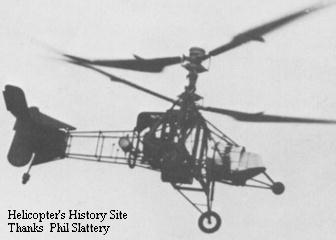
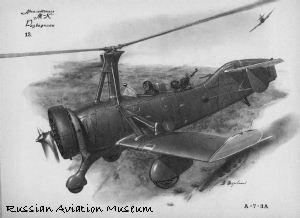
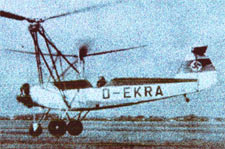
 1936 : Weir W.3 ( Great Britain )
1936 : Weir W.3 ( Great Britain )
 1937 :
Froebe, Canadian first helicopter
1937 :
Froebe, Canadian first helicopter
 1938 :
Platt-LePage Aircraft Co XR-1 ( 1941 / 1944 )
1938 :
Platt-LePage Aircraft Co XR-1 ( 1941 / 1944 )
 1938, May 19 :
Comes carried out to Washington the first flight mails with an autogyro.
The regular service, carried out with a Kellet KD-1 of the Eastern
Airlines, began July 6th, but then it was abandoned for practical reasons.
1938, May 19 :
Comes carried out to Washington the first flight mails with an autogyro.
The regular service, carried out with a Kellet KD-1 of the Eastern
Airlines, began July 6th, but then it was abandoned for practical reasons.
 1939 :
Weir W.6 - First with two seats
1939 :
Weir W.6 - First with two seats
 1939 :
Igor Sikorsky (USA)
The VS 300 was the first useful single-rotor
helicopter. A design refined enough to be converted in the R-4
years later and put into production.
1939 :
Igor Sikorsky (USA)
The VS 300 was the first useful single-rotor
helicopter. A design refined enough to be converted in the R-4
years later and put into production.
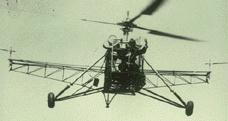
 1939 :
Kellett KD-1B autogiro ( USA )
1939 :
Kellett KD-1B autogiro ( USA )
 1940 :
Focke-Achgelis Fa 223 Drache
Focke biggest helicopter, it was tried to use in order to free Mussolini in imprisonment
on the "Gran Sasso", but at the last moment, because of a damage, the rescue was done
with an airplane Fi 156 Storch.
First helicopter to fly the English Channel (May 1945).
1940 :
Focke-Achgelis Fa 223 Drache
Focke biggest helicopter, it was tried to use in order to free Mussolini in imprisonment
on the "Gran Sasso", but at the last moment, because of a damage, the rescue was done
with an airplane Fi 156 Storch.
First helicopter to fly the English Channel (May 1945).
 1940 : Gyrocraft Mil A-15
1940 : Gyrocraft Mil A-15
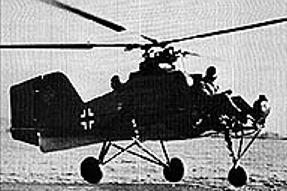
 1940/50 : Ivan Bratukhin 's Omega, G-3/4, B-5,9/11 (USSR)
1940/50 : Ivan Bratukhin 's Omega, G-3/4, B-5,9/11 (USSR)

 1942 : Focke-Achgelis Fa 330 Bachstelze
1942 : Focke-Achgelis Fa 330 Bachstelze
Flights results were disappointing and the aircraft was abandoned
When he received the castings, he discovered that the patterns he had made had not been correct and the castings would not fit together, so he abandoned the idea of building a full size machine, and simply made drawings of his idea.
He asked his son-in-law Rex. L. Beach who was studying Marine Engineering and Naval Architecture at the University of Michigan, to make blue prints of his drawings. Whitney sent them to the US Aeronautics Commission, and after some time he received a reply stating that his ideas were not new.
In 1939, Sikorsky produced his first helicopter with three of Whitney 's ideas incorporated, and Pitcairn came out with a new Autogiro, both had been on the commission to which he had sent his drawings to during that time frame.




1941 :
Flettner FL 282 Kolibri
Nazi Germany is the first to use helicopters in combat. Fa223, Fl265 y Fl282 were used for rescue, artillery spotting and convoys submarine protection.
Nazi Germany is the first to use helicopters in combat. Fa223, Fl265 y Fl282 were used for rescue, artillery spotting and convoys submarine protection.
Most Advanced WWII Helicopter


